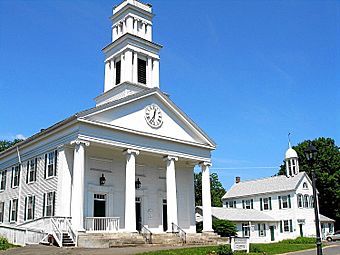Plymouth Center Historic District facts for kids
|
Plymouth Center Historic District
|
|
 |
|
| Lua error in Module:Location_map at line 420: attempt to index field 'wikibase' (a nil value). | |
| Location | Roughly along Main, North, and South Sts., Carter, Hillside Ave., Ives Crossing, and Maple St., Plymouth, Connecticut |
|---|---|
| Area | 130 acres (53 ha) (original size) 6 acres (2.4 ha) (size of 2000 increase) |
| Architectural style | Colonial, Federal, et al. |
| NRHP reference No. | 99000858 (original) 00001474 (increase) |
Quick facts for kids Significant dates |
|
| Added to NRHP | July 22, 1999 |
| Boundary increase | December 7, 2000 |
The Plymouth Center Historic District is a special area in Plymouth, Connecticut. It shows what an old village center looked like a long time ago. This area grew in the 1800s with small businesses. Later, it became less busy as another part of town, Thomaston, became its own town. Also, more factories grew in Terryville. The district has buildings with cool old styles like Colonial, Federal, and Greek Revival. It became a protected historic place in 1999.
Contents
What is the Plymouth Center Historic District?
This historic district is like a time capsule! It covers the old village center of Plymouth. You can find it mostly along Main Street, between Carter Road and Maple Street. It also goes a bit north on North Street and south on South Street.
The district was added to the National Register of Historic Places in 1999. This means it is an important place in American history. A small part of the district was made larger in 2000.
A Look Back: Plymouth's Early Days
The land that is now Plymouth was once part of Waterbury. People first set up a separate church area here in the 1740s. Plymouth, which included Thomaston back then, became its own town in 1795.
The first town center was where Main Street met North and South Streets. The first church meetinghouse was on the southeast corner. The town common, a public park, was on the northwest corner.
How Plymouth Grew and Changed
The village became very busy in the 1800s. Many small businesses and industries started here. But things changed later in the century.
In 1875, Thomaston became its own separate town. This was a big economic change for Plymouth. Also, more factories and jobs moved to the Terryville area. This made the old town center less important.
Buildings and Styles You'll See
Plymouth Park, the old town common, is still a main spot. You can see important religious and town buildings around it. One is the Congregational Church, built in 1838. It has a Greek Revival style, which looks like old Greek temples.
Another building is the stone Gothic former St. Peter's Episcopal Church. It was built in 1915. Today, a Baptist church uses this building.
The most common building style in the district is Greek Revival. You can see it in fancy houses. You can also see simpler versions in the homes where workers lived on Maple Street. These buildings tell the story of Plymouth's past.

